| Srl | Item |
| 1 |
ID:
123051
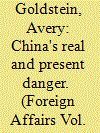

|
|
|
|
|
| Publication |
2013.
|
| Summary/Abstract |
Much of the debate about China's rise in recent years has focused on the potential dangers China could pose as an eventual peer competitor to the United States bent on challenging the existing international order. But another issue is far more pressing. For at least the next decade, while China remains relatively weak compared to the United States, there is a real danger that Beijing and Washington will find themselves in a crisis that could quickly escalate to military conflict. Unlike a long-term great-power strategic rivalry that might or might not develop down the road, the danger of a crisis involving the two nuclear-armed countries is a tangible, near-term concern -- and the events of the past few years suggest the risk might be increasing.
|
|
|
|
|
|
|
|
|
|
|
|
|
|
|
|
| 2 |
ID:
137579
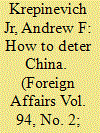

|
|
|
|
|
| Summary/Abstract |
In the U.S. military, at least, the “pivot” to Asia has begun. By 2020, the navy and the air force plan to base 60 percent of their forces in the Asia-Pacific region. The Pentagon, meanwhile, is investing a growing share of its shrinking resources in new long-range bombers and nuclear-powered submarines designed to operate in high-threat environments.
|
|
|
|
|
|
|
|
|
|
|
|
|
|
|
|
| 3 |
ID:
131571
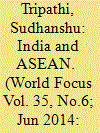

|
|
|
|
|
| Publication |
2014.
|
| Summary/Abstract |
The emerging economic cooperation between India and ASEAN nations will be a great achievement for both the partners and will demonstrate enough potential for an ever increasing multifarious partnership, leading to all round growth and prosperity. Furthermore, the cooperation between them will add to their collective power with which they can effectively stand against the rising menace of terrorism and other socio-economic and political challenges in the East. Also, their unity and strength will deter outside powers from intervening into their internal affairs and will work as a strong regional bulwark against undue sovereign claims by China over entire South China Sea and also over territories of almost all of the ASEAN nations, particularly, Vietnam and Philippines and the same holds good in case of Japan and South Korea as regards territories of East China Sea and also other adjacent areas respectively.
|
|
|
|
|
|
|
|
|
|
|
|
|
|
|
|
| 4 |
ID:
128429
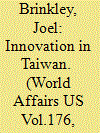

|
|
|
|
|
| Publication |
2014.
|
| Summary/Abstract |
Taiwan's president, Ma Ying-jeou, sat in a low leather chair looking out over the vast presidential conference room of his Taipei office. On the wall behind him hung a portrait of Sun Yat-sen, the Chinese icon who is credited with the revolution a century ago that ended two thousand years of imperial rule. Under Ma's feet lay a light blue carpet festooned with white representations of ocean waves. Overhead, white cloth, styled like ship sails, covered the ceiling lights-all of it intended to represent Taiwan's journey away from mainland China. Asian conference rooms are unlike those in the West. There's no mahogany conference table. Instead, plush chairs are arranged in a U shape. And the conference leader, in this case President Ma, sits at the center with his conferees to his left and right-university professors, think tank leaders, and government officials from Asia and the West who were there for a conference on the East China Sea debate between Taiwan, China, and Japan.
|
|
|
|
|
|
|
|
|
|
|
|
|
|
|
|
| 5 |
ID:
119709
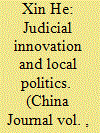

|
|
|
| 6 |
ID:
143268


|
|
|
|
|
| Summary/Abstract |
The assertive actions China has taken to press its claims in the East China and South China seas since 2010 indicate that its leadership has decided that the time has come to end Deng Xiaoping's advice to “hide [the country's capabilities] and bide [its time].” Beijing has combined economic incentives and sanctions with small but incrementally meaningful military pressures. Efforts by neighboring states to form a countervailing coalition have thus far proved ineffective. Beijing's tactics have been stunningly successful, though there are financial, structural, and resource weaknesses within China that indicate that the effort to assert control over the area will remain unrealized.
|
|
|
|
|
|
|
|
|
|
|
|
|
|
|
|
| 7 |
ID:
123358


|
|
|
|
|
| Publication |
2013.
|
| Summary/Abstract |
Although China's assertiveness has been a major factor in the latest hardening of relations in East Asia, Beijing's retreat from soft power has not necessarily benefited those who are viewing the rise of China most anxiously."
|
|
|
|
|
|
|
|
|
|
|
|
|
|
|
|
| 8 |
ID:
103885


|
|
|
|
|
| Publication |
2011.
|
| Summary/Abstract |
The present paper attempts to combine cointegration theory and the material flow analysis approach to examine the causal relationship between resource use and real GDP in Jiangsu Province in East China. The study considers the period from 1990 to 2007. We use direct material input as the proxy variable for resource use. Our estimation indicates that real GDP and resource use are cointegrated and there is only unidirectional long-run Granger causality running from resource use to real GDP, but not vice versa. The estimation results mean that resources are a limiting factor in terms of economic growth, and, therefore, strategies should be adopted for more vigorous economic development and consistent resource use in East China. Furthermore, the novel idea and methodology involved in the present study can be readily extended to cover other regions for the analysis of the relationship between resource use and economic growth.
|
|
|
|
|
|
|
|
|
|
|
|
|
|
|
|
| 9 |
ID:
128331
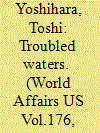

|
|
|
|
|
| Publication |
2014.
|
| Summary/Abstract |
Japan and China have been staring each other down in the East China Sea for well over a year now. Since Tokyo nationalized the Senkaku/Diaoyu Islands in September 2012, Chinese "maritime law enforcement flotillas" have been making the rounds in the disputed waters near the islands. China insists that the regular patrols are routine and normal. Japanese Coast Guard vessels have been working overtime to monitor and trail every Chinese intrusion, lest Tokyo concede Beijing's jurisdictional claims. Before this so-far low-decibel crisis began, it seemed unlikely that China would be willing to contest Tokyo's sovereignty over the uninhabited islands-islets is actually a better term to describe them-and administrative control over surrounding waters for as long as it has. And even fewer thought that Japan would be straining for an appropriate response. It is a testament to changing assumptions about China's growing ambitions that this protracted test of wills has gone largely unreported in the Western press. This cat-and-mouse game has seemingly become the new normal in maritime Asia.
|
|
|
|
|
|
|
|
|
|
|
|
|
|
|
|
| 10 |
ID:
151333


|
|
|
|
|
| Summary/Abstract |
In recent years, China has started throwing its weight around. It has defied international law and risked violent clashes in the East China and South China Seas [2]. It has bent trade rules by discriminating against foreign businesses to help its own. It has tried to shut out foreign influences while promoting its own propaganda abroad. And it has resisted [3] Western demands that it put more pressure on its ally North [4]Korea [4]. China’s new assertiveness stems, in part, from its growing power; the country now boasts the world’s second-largest economy and its second-largest military budget. But domestic insecurities have also played a role.
|
|
|
|
|
|
|
|
|
|
|
|
|
|
|
|